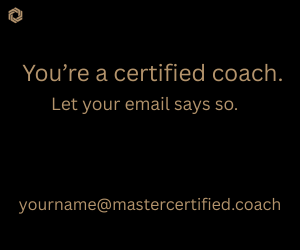We all have the ingredients to establish ourselves as thought leaders. As coaches, we develop unique perspectives based on our personal experiences, expertise, and values. These unique perspectives become thought leadership when they leave our minds in service of others.
The challenge is that we, too often, are not communicating our own thought leadership. We stop short, finding ourselves only thought sharing. We forward along someone else’s research, or click ‘like’ on another’s post. Maybe we recommend an author’s book. Yes, thought sharing is helpful and supports community-building. It’s also insufficient for growing a coaching practice.
Growing a coaching practice requires differentiating yourself through your own thought leadership. Thought leadership requires two components:
- An informed expression of an idea.
- Communication of that idea to help others learn or explore the topic.
For example, an executive coach may be a thought leader on imposter syndrome. A life coach can be a thought leader on mindfulness practices. A wellness coach could be a thought leader on burnout. A mentor coach might be a thought leader on powerful questions. Thought leadership signals who you are as a coach, builds credibility, increases your reach, and helps attract your ideal coaching clients.
Thought leadership, however, has no impact if it stays in your head. We can’t just think the thought. We have to communicate it. Numerous avenues exist for communicating your thought leadership:
- Posting original content on LinkedIn or other social media.
- Adding your perspective to someone else’s post on LinkedIn or other social media.
- Keynote speaking.
- Teaching.
- Hosting webinars.
- Serving on panels.
- Interviewing on podcasts.
- Mentoring.
- Authoring books, chapters, articles, and blogs.
- Conducting research.
- Critiquing others’ books or research.
Are you thinking you may not be a thought leader? Maybe a touch of imposter syndrome or self-limiting belief is creeping in right about now? Consider the thoughts you have in your head, and in your heart, right now. Those thoughts are sources of thought leadership, if nurtured. For example:
- Have you ever had a strong reaction reading a book or reviewing research? That reaction is a point of view. That point of view is formed from your unique experiences, training, and perspectives. That point of view, if communicated, becomes your thought leadership.
- Do people come to you regularly for help with a particular type of goal? That goal is likely where your strengths as a coach are most valued. That value, if communicated, becomes your thought leadership.
- Are you known for helping clients work through a particular type of question? That question is perceived by others as your specialty. That specialty, if communicated, becomes your thought leadership.
- When you coach a client, do you frequently hear, “Thank you. I never thought of it that way before.” Evidence shows your approach to unlocking client insights works. That approach, if communicated, becomes your thought leadership.
The next time you’re tempted to like or share someone’s post, stop a moment and ask, “What is my point of view on this topic?”
Move beyond thought sharing. Signal your unique voice as a coach. Communicate your thought leadership.
© The Me-Suite LLC 2023
Donna Peters, ACC, will be exploring this topic more in-depth at ICF Converge 2023, which is taking place August 23-26 in Orlando, Florida, USA. Join her session “Establishing Yourself as a Thought Leader” in the Expand theme on Thursday, August 24 at 5:30 p.m. (local conference time). By attending this session, you can earn 0.75 in Continuing Coach Education units in Resource Development.
Disclaimer
The views and opinions expressed in guest posts featured on this blog are those of the author and do not necessarily reflect the opinions and views of the International Coach Federation (ICF). The publication of a guest post on the ICF Blog does not equate to an ICF endorsement or guarantee of the products or services provided by the author.
Additionally, for the purpose of full disclosure and as a disclaimer of liability, this content was possibly generated using the assistance of an AI program. Its contents, either in whole or in part, have been reviewed and revised by a human. Nevertheless, the reader/user is responsible for verifying the information presented and should not rely upon this article or post as providing any specific professional advice or counsel. Its contents are provided “as is,” and ICF makes no representations or warranties as to its accuracy or completeness and to the fullest extent permitted by applicable law specifically disclaims any and all liability for any damages or injuries resulting from use of or reliance thereupon.
Authors
Post Type
Blog
Audience Type
Experienced Coaches, External Coaches, ICF Chapter Leaders, Internal Coaches, Mentor Coaches, New Coaches, Professional Coaches, Team and Group Coaches
Topic
Building a Successful Coaching Business, Business Development
Related Posts
The Executive Coaching Blueprint: Positioning, Pricing, and Performance
Transitioning from corporate to coach can feel like uncharted territory for many…
Why Coaches Need Other Coaches
Setting the Foundation When you’re learning about the field of coaching while…
Expanding Coaching Possibilities With the Coaching Spectrum Framework™
When I discovered coaching 14 years into my career as an occupational…








